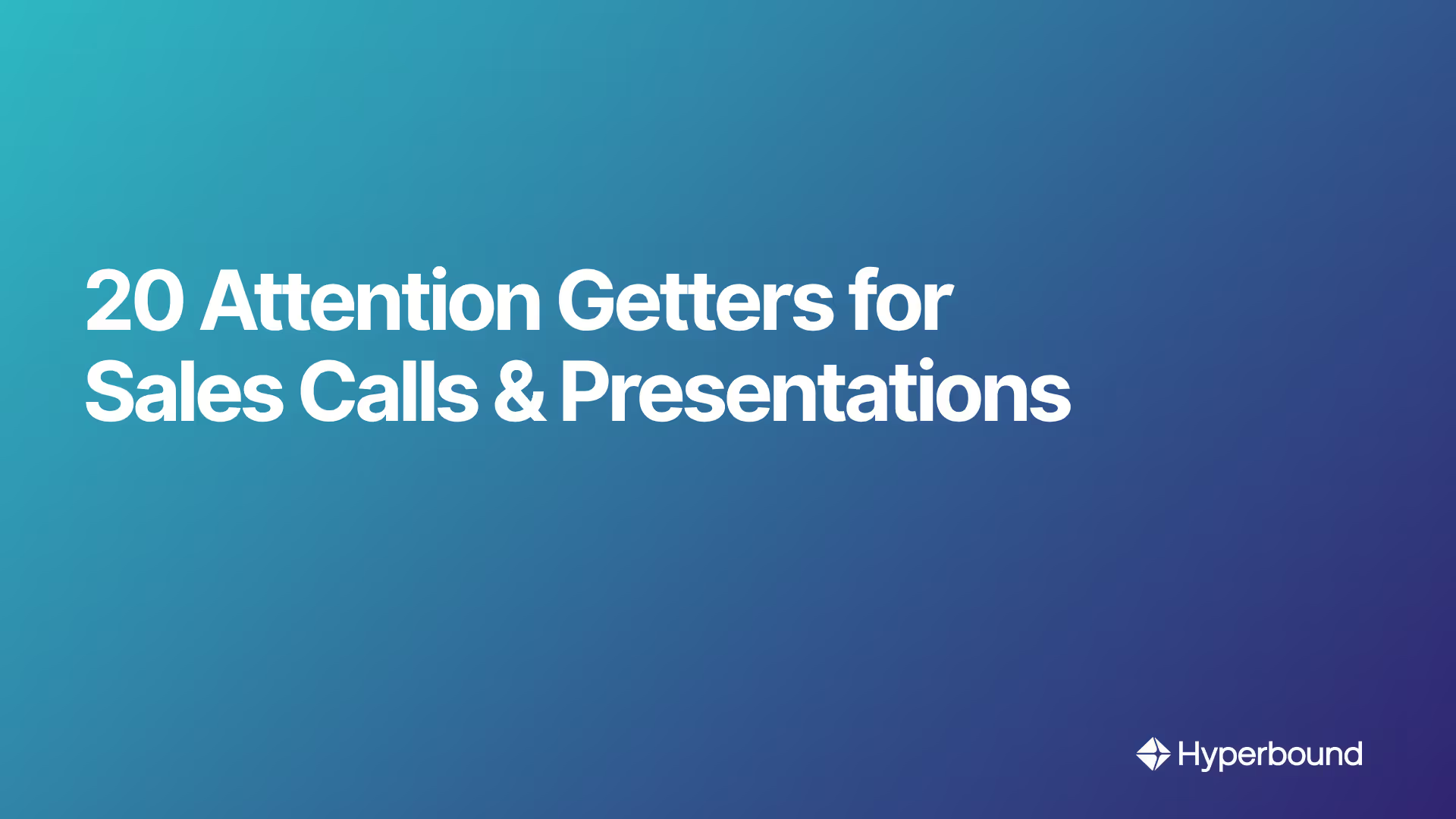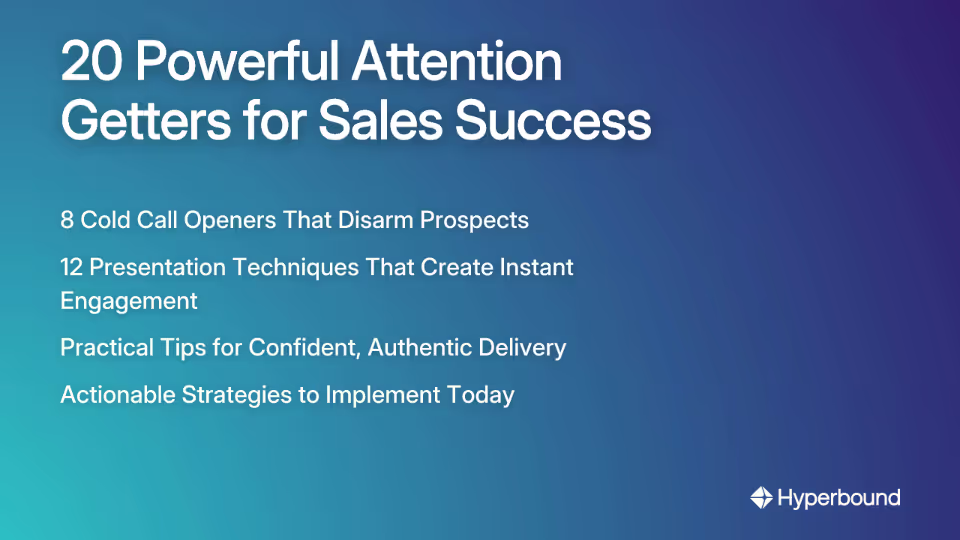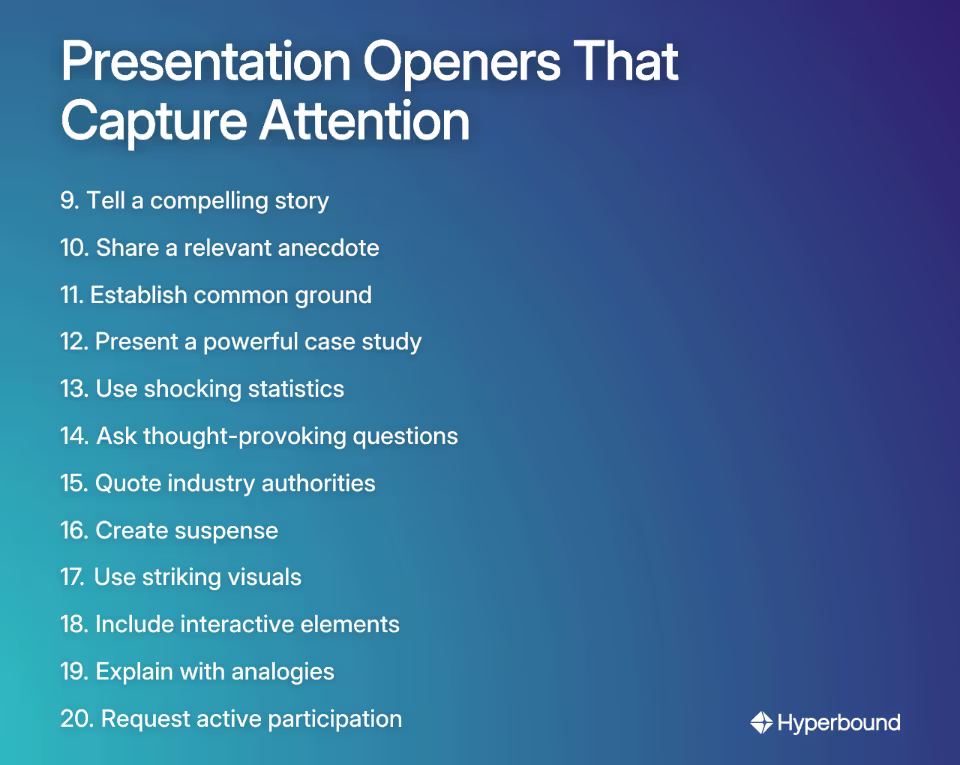
You have 8 seconds.
That's how long the average human attention span lasts today. In that fleeting moment, you must capture your prospect's interest before their mind wanders to the other 4,000+ messages bombarding them daily.
Whether you're facing the dreaded "cold call" or standing before a room of potential clients, those first few seconds can make or break your entire sales effort. A weak opener sends your carefully crafted presentation straight to the mental trash bin.
"I received poor feedback about my presentation during an internal design review," one UX designer confessed on Reddit. "My boss mentioned I took too long to present the design. This has impacted my self-confidence."
Sound familiar? You're not alone.

The good news: powerful attention getters solve this problem. These strategic openers immediately engage your audience, establish credibility, and set the stage for a productive conversation.
This article provides 20 proven attention getter examples for both sales calls and presentations, helping you command attention from the very first moment.
For Cold Calls: Disarming & Direct Openers

1. "We haven't met before."
This honest, straightforward approach immediately sets you apart from typical salespeople who launch into rehearsed pitches. It acknowledges the reality of the situation and signals authenticity.
2. "This call will take three minutes."
By setting a clear time expectation upfront, you respect the prospect's schedule and reduce their anxiety about getting trapped in a long conversation. They're more likely to give you their full attention for a defined period.
3. "I'm lost. Can you help me?"
This vulnerability-based opener positions the prospect as the expert, encouraging engagement by appealing to their natural desire to help. It transforms the dynamic from seller-to-buyer to a collaborative conversation.
4. "I don't know much about your company..."
Displaying genuine curiosity invites the prospect to talk about their business—something they know and care deeply about. This shifts from monologue to dialogue and provides valuable insights for your pitch.
5. "Our companies have spoken in the past, but I haven't reached out before..."
This provides important context that warms up the call if there's a history with their organization, making it easier to establish a connection.
6. Use the "favorite cousin" mindset.
As one sales professional shared on Reddit: "As soon as they pick up, talk to them like they're your favorite cousin that just showed up on Thanksgiving." This mental shift transforms your tonality and creates instant rapport.
7. "I noticed you recently..."
Reference something specific about the prospect or their company from LinkedIn, their website, or recent news. This demonstrates that you've done your homework and aren't making random calls.
8. "Most [role/industry] leaders I speak with are struggling with..."
This opener positions you as someone familiar with their challenges while inviting them to confirm or deny if the same issues apply to them.

For Presentations: Building Connection & Intrigue

9. Start with a captivating story
Begin with an emotional, shocking, or compelling personal story that relates to your topic. Stories activate more areas of the brain than facts alone, making your message more memorable.
According to one Reddit user discussing presentation skills, "Include a story" is among the best advice for creating engaging presentations. Stories create emotional connections that dry facts simply can't match.
10. Share a funny, true anecdote
A relevant and amusing anecdote not only engages the audience with humor but also helps establish your credibility by making you more relatable and human. Just ensure the humor is appropriate for your audience and relevant to your message.
11. Establish common ground
Reference something you share with the audience—a recent industry challenge, a common goal, or a shared experience. This fosters an immediate connection and creates a sense of "we're in this together."
12. Open with a powerful case study
Begin with a brief, compelling case study that demonstrates the impact of your solution. This works because case studies combine storytelling with concrete results—63% of marketing professionals find case studies to be effective for lead generation.
13. Present a shocking statistic or bold statement
Open with a surprising statistic or a bold statement that challenges common assumptions. For example: "Did you know that 80% of users read headlines, but only 20% continue to read the rest?"
This immediately highlights the significance of your topic and builds your credibility by demonstrating your expertise.
14. Ask a powerful question
Engage your audience's minds with either a rhetorical question that makes them reflect ("What if you could cut your production time in half?") or a direct question that prompts a response ("Raise your hand if you've ever felt overwhelmed by your project deadlines.").
15. Use a relevant quote
Start with a powerful quote from a recognized authority in your field. This can lend credibility to your message and set the tone for the entire presentation. Choose something thought-provoking that directly relates to your key message.
16. Create suspense
Tease the main point or the "big reveal" of your presentation without giving it away. Hint at a solution to a major problem you're about to unveil, sparking curiosity and making the audience want to stay engaged to discover the answer.
17. Use a powerful visual or prop
A single, striking image, infographic, or physical prop can be more effective than slides full of text. As one UX designer advised on Reddit, "Less is more, especially text. Avoid text on slides if possible." This creates an immediate visual anchor for your message.
18. Launch an interactive element
Start with a quick poll, a short quiz, or an activity that involves the audience from the beginning. This transforms passive listeners into active participants and increases their investment in your presentation.
19. Use an analogy or metaphor
Explain a complex idea by comparing it to something familiar. Analogies make abstract concepts more concrete and understandable, generating interest and clarity. For example, "Our security system works like your body's immune system..."
20. Request direct audience involvement
Explicitly ask for participation. This could be asking audience members to turn to a neighbor and discuss a question for 30 seconds or asking for a volunteer. This makes them active participants, not passive listeners.
Delivering Your Attention Getters Effectively
Tailor to your specific audience
One critical insight from presentation experts is to "Understand what is expected of you, i.e., subject AND audience." What works for an internal design review won't necessarily work for a client pitch. Research your audience's background, pain points, and expectations.
Preparation conquers fear
As one public speaking advisor shared on Reddit: "If it's really freaking you out, run the presentation at least 10 times or at least until it becomes nearly automatic. Preparation is, in my opinion, the most important thing." While rehearsing in front of a mirror is a classic technique, platforms like Hyperbound allow you to practice against realistic AI buyer personas, giving you a significant edge.
A smooth, confident delivery signals competence and helps your attention getter land as intended.
Motion creates emotion
Before your call or presentation, use physical movement to increase your energy. One sales professional noted: "As soon as someone picks up, I'm on my feet pacing the room." This simple technique can dramatically improve your voice's energy and engagement level.
Balance branding and value
While your company is important, avoid leading with heavy branding. Focus first on the value you're providing and the problems you're solving. Once you've captured attention with something meaningful to them, your brand will naturally gain relevance.
Find Your Hook
The perfect attention getter isn't universal—what fits for one situation won't fit for another. The key is finding authentic openers that feel natural to you while resonating with your specific audience.
Remember that these techniques work for both sales calls and presentations because they tap into fundamental human psychology: our desire for stories, our curiosity about new information, and our need to feel understood.
Start by selecting one attention getter from this list that feels most comfortable, and commit to using it in your very next sales call or presentation. Track your results, refine your approach, and gradually expand your repertoire of attention-grabbing techniques.
With practice, you'll develop the confidence to command attention from those crucial first seconds. AI coaching tools can accelerate this process by providing instant feedback on both practice roleplays and real calls, helping you quickly refine your delivery. This transforms potential tune-outs into engaged, receptive audiences ready to hear what you have to say.
Frequently Asked Questions
What is the best attention getter for a sales call?
The best attention getter for a sales call is one that is honest, respects the prospect's time, and opens a two-way conversation. Techniques like acknowledging it's a cold call ("We haven't met before"), setting a clear time limit ("This call will take three minutes"), or showing genuine curiosity ("I don't know much about your company...") are highly effective. The goal is to disarm the prospect and move from a traditional sales pitch into a collaborative discussion.
How can I make my presentation opening more engaging?
To make your presentation opening more engaging, start with a compelling story, a shocking statistic, or an interactive element. These methods tap into human psychology by creating an emotional connection (stories), sparking curiosity (statistics), or turning passive listeners into active participants (interactive polls). Avoid starting with a lengthy agenda; focus on capturing interest first.
Why are attention getters so important in sales?
Attention getters are crucial in sales because you only have about 8 seconds to capture a prospect's interest before they lose focus. In today's world, people are bombarded with thousands of messages daily. A strong opening breaks through the noise, establishes your credibility, and sets a positive tone for the entire interaction. A weak opener can cause the prospect to disengage immediately, no matter how valuable your solution is.
How do I choose the right attention getter for my audience?
Choose the right attention getter by researching your audience and tailoring your opener to their specific context, challenges, and communication style. What works for a formal executive board presentation (e.g., a powerful case study) may not work for a casual internal team meeting (e.g., a funny anecdote). The most effective openers show you've done your homework and understand their world.
What should I do if my attention-grabbing opener doesn't work?
If your opener doesn't land as expected, stay calm, acknowledge it if necessary, and smoothly transition to your main point or ask a direct question to re-engage the audience. Not every opener will be a home run. The key is to remain confident and adaptable. This is where practice becomes invaluable for handling unexpected reactions gracefully.
How can I practice delivering attention getters confidently?
Practice is the key to confident delivery. Rehearse your openers repeatedly until they feel natural and automatic. You can practice in front of a mirror, record yourself, or roleplay with colleagues. For more targeted practice, AI coaching platforms like Hyperbound allow you to test your attention getters against realistic AI buyer personas, providing a safe space to refine your tone and delivery before engaging with actual prospects.

Book a demo with Hyperbound
.png)













